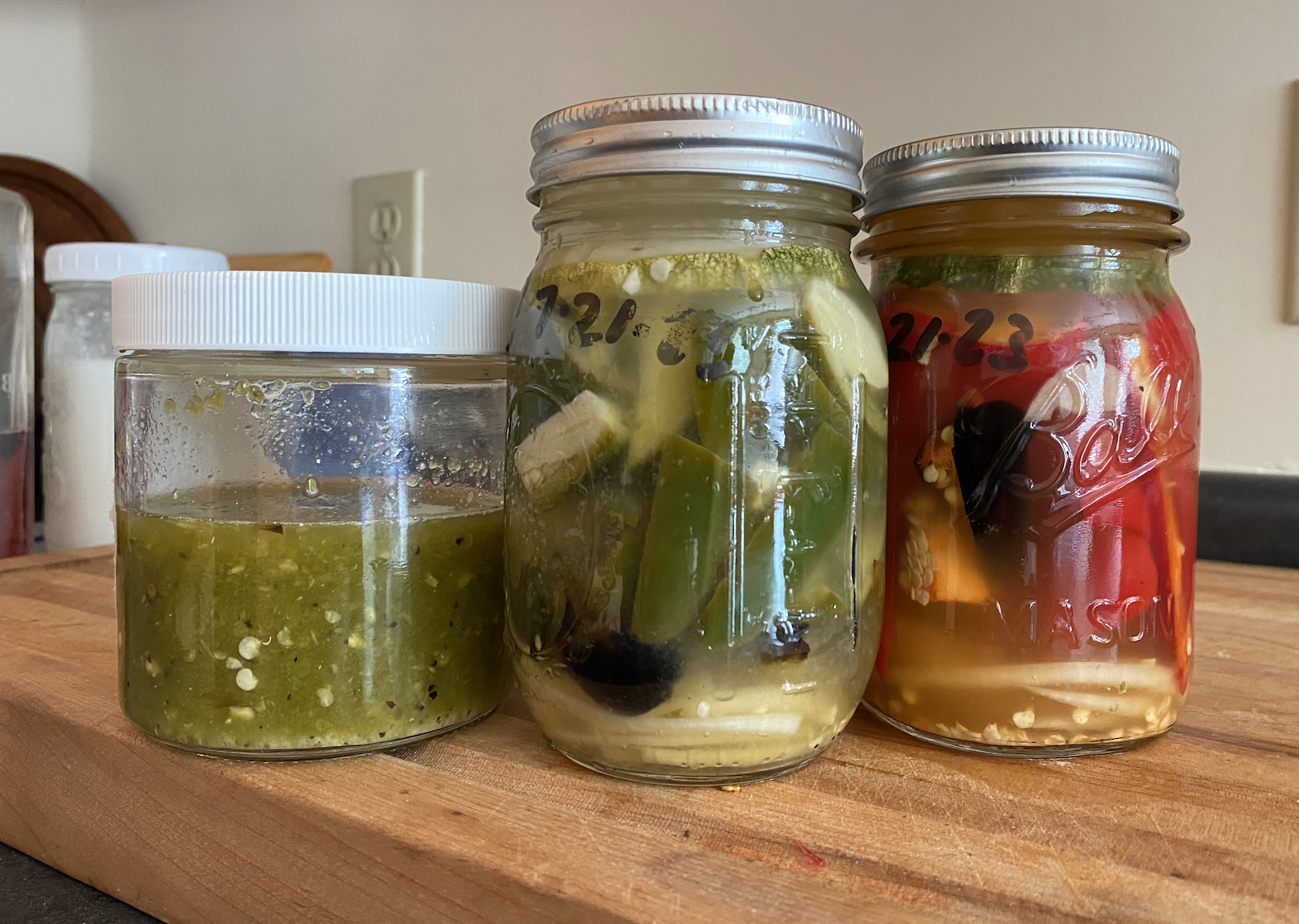Fermented peppers of all kinds are delicious. You can create your own signature blends of flavor and heat (or not) with a fermented pepper condiment that adds zest and zing to any dish. You might even add a drop of fermented hot sauce into a cocktail for an eye-opening beverage experience. This technique works for sweet pepper ferments too. Simply chop the bell peppers as you like them and follow the fermentation recipe, stopping and refrigerating the peppers once they reach the flavor you desire.
Ingredients and equipment:
6 peppers - I’ll keep it simple and use 6 jalapeños, but you can choose whichever peppers you desire. Mix and match once you have the basic technique down.
1/2 onion, (3 cloves of garlic (optional, but garlic is a good good thing)
1/2 T peppercorns (black, or your choice)
3% brine (15 g salt + 500 ml water or 2 tsp salt + a pint of water)
shot (+/- 1/4 c) of previous fermentation liquid, sauerkraut juice or yogurt whey (optional, but gives the fermentation a boost, especially if you’ve grilled some of your peppers)
1-2 mason jars with shoulders, lids
1/2 inch thick slice round vegetable (turnip? daikon? wide carrot?) to wedge into the jar under the shoulders. or other submersion method like a ziplock filled with brine
blender (immersion blender, Vitamix whatever you’ve got), colander, bowl
apple cider vinegar (or another preferred vinegar)
cutting board, sharp knife
cookie sheet and broiler, or grill (if you wish to add a smoky quality to your sauce)
Method:
I like to ferment the peppers in chunks and then puree them once they are fermented. You could also ferment pre-puréed veggies, but it’s harder to keep the mash submerged and you’ll risk mold contamination.
1) To grill some or all of your peppers, broil or grill them whole until a bit charred on all sides. Remove from the oven until cool enough to handle, then remove the stem and seeds.
2) stem and chop all your peppers into chunks (with or without seeds - your choice). Slice the onions into 1/4 inch or thinner slices. cut garlic cloves in half.
3) Into your mason jar with shoulders, put the black peppercorns, followed by the onion slices, garlic and then the peppers. Add anything else you’d like (herbs? spices?), but put smaller items on the bottom so they don’t float and can be held down by the vegetable chunks. Leave at least 1-2 inches of space below the shoulder of the jar.
4) Pour in 3% brine to cover the vegetables to the shoulder level. Add a shot of liquid from a previous fermentation, especially if a lot of your peppers are grilled (= sterilized).
5) Wedge a large disc of turnip/carrot/radish under the jar’s shoulders to keep the veg submerged. Top up with more brine/fermentation liquid to cover the disc by at least 1 inch. The disc will be sacrificial, and composted once it’s done its job of keeping the peppers etc. underwater until the end of the fermentation period.
6) Ferment for a week or two in a cupboard. Put the jars on a tray - your ferment might bubble over a bit. Check it every morning to ensure the peppers are still submerged, push down on the disc to encourage the bubbles to fizz out, or slide a knife down the side. Another way of keeping the veggies underwater is to put a ziplock filled with brine on top of the ferment. The goal is to keep the fermenting vegetable mass anaerobic.
7) Taste a pepper every once in a while (you might have to rearrange the jar a bit to access one). Once it reaches the desired flavor, discard the top veggie disc, and drain your ferment through a colander into a bowl (save the liquid!) If you are simply fermenting sweet peppers, once they have reached the flavor you like, tighten the lid and put them in the fridge - DONE.)
8) In a food processor, put your drained fermented vegetables, 1/4 cup of the fermentation liquid and 1/4 cup of apple cider vinegar (or a different vinegar) and whizz it up. This is where the mixture becomes your own. More or less vinegar? A little bit of sugar? Some fresh fruit?
9) Once you’ve blended your mash to your taste, you can leave it as a blend or you can strain the liquid out and package as drops (if you’ve chosen really fiery peppers, this might be the way to go).
10) This ferment will last almost indefinitely in the fridge, and they make great gifts.
I love fermented pepper sauce on eggs, fish tacos, drizzled on soups, mixed into a salad dressing, zinging up a stews, or even a drop into a cocktail - your imagination is the limit!

